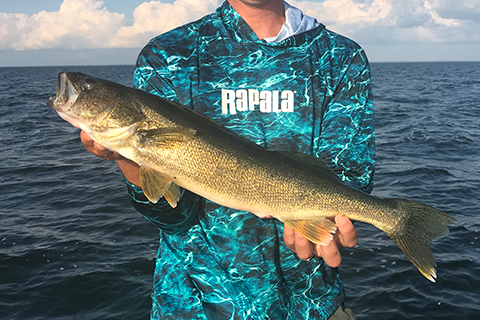As the water warms, walleyes tend to move away from shorelines and scatter on flats and along deeper water structure. This provides the perfect scenario for dragging spinners behind bottom bouncers to cover water and seek active fish.
Start by putting your electronics to work. Use GPS maps to locate structure away from shorelines, then pay attention to your sonar to find the depth of the fish. Don’t forget about the wind. A strong, consistent wind can stack fish up on one side of a piece of structure or against a shoreline.
 The depth where you mark fish will help determine which size bottom bouncer to use. The basic rule: one ounce of weight for every 10 feet of depth. A 2-ounce bottom-bouncer is pretty versatile, but a 3-ouncer may be necessary to get your spinner down to the bottom when fishing around 30-feet deep.
The depth where you mark fish will help determine which size bottom bouncer to use. The basic rule: one ounce of weight for every 10 feet of depth. A 2-ounce bottom-bouncer is pretty versatile, but a 3-ouncer may be necessary to get your spinner down to the bottom when fishing around 30-feet deep.
You want to keep your line at about a 45-degree angle for the best action and feel of your presentation. You can either hold the rod or drop it in a rod-holder and troll along at .8 to 1.5 mph. Depending on the bite, using a rod-holder can be more productive. Oftentimes allowing the rod to load up when a fish strikes will result in better hookup rates. Many times when anglers hold the rod in their hand, they set the hook too quickly thus getting many short strikes and missing fish. By allowing that rod to load the fish is setting the hook itself when it takes the hook.
I like to hold the rod in my hand and feel the bite. This helps me determine whether to wait for them to load up, drop the rod tip a bit to give the fish another chance to take the bait, or pull away from pesky perch or sunfish. This also allows me to raise and lower my presentation quicker to stay in the strike zone as the depth changes.
My go-to bait on spinner rigs is crawlers, but there are times were minnows, leeches, or even artificial baits can be more productive. Artificial baits can be more productive, especially when dealing with large numbers of perch because artificials allow you to keep your presentation in the water longer.
When it comes to choosing blade colors I tend to start out with perch patterns first and then try other colors matching the forage base in the lake I’m fishing. Silver and gold can be effective minnow imitators, and orange colors works if there are a lot of crayfish. Sometimes, however, fish prefer the oddest colors like pinks and purples. Start with the basics and experiment. If you have more people in the boat, vary colors until you determine what is working best.
One of my most important tips is to not stick with something that isn’t working. If you are marking fish and not getting bites, change it up. Adjust your speed, bait type, lure color, or size of lure. You can also experiment with leader length. When you are dealing with clear water and little wind you usually will have to use a longer leader. My minimum length is about 4 feet and I have gone as long as 10 feet.
A 7-foot or longer rod is important when running longer leaders to make landing fish easier. Just real line up close to your bottom bouncer and lift up and sweep the rod forward to bring the fish towards you and into the net.
Good luck fishing and stay safe.






